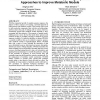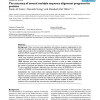662 search results - page 82 / 133 » Making inferences with small numbers of training sets |
CLADE
2008
IEEE
14 years 3 months ago
2008
IEEE
With the exponential growth of complete genome sequences, the analysis of these sequences is becoming a powerful approach to build genome-scale metabolic models. These models can ...
ISMIR
2003
Springer
14 years 2 months ago
2003
Springer
Automatic extraction of content description from commercial audio recordings has a number of important applications, from indexing and retrieval through to novel musicological ana...
TMI
2010
13 years 7 months ago
2010
—We present a computer-aided detection (CAD) system for computed tomography colonography that orders the polyps according to clinical relevance. The CAD system consists of two st...
BMCBI
2006
13 years 9 months ago
2006
Background: There have been many algorithms and software programs implemented for the inference of multiple sequence alignments of protein and DNA sequences. The "true" ...
ICML
2007
IEEE
14 years 9 months ago
2007
IEEE
Maximum margin clustering (MMC) is a recent large margin unsupervised learning approach that has often outperformed conventional clustering methods. Computationally, it involves n...


